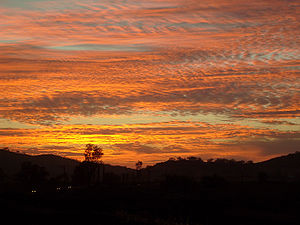
Atmospheric optics is "the study of the optical characteristics of the atmosphere or products of atmospheric processes .... [including] temporal and spatial resolutions beyond those discernible with the naked eye".[1] Meteorological optics is "that part of atmospheric optics concerned with the study of patterns observable with the naked eye".[2] Nevertheless, the two terms are sometimes used interchangeably.
Meteorological optical phenomena, as described in this article, are concerned with how the optical properties of Earth's atmosphere cause a wide range of optical phenomena and visual perception phenomena. Examples of meteorological phenomena include:
- The blue color of the sky. This is from Rayleigh scattering, which sends more higher frequency/shorter wavelength (blue) sunlight into the eye of an observer than other frequencies/wavelength.
- The reddish color of the Sun when it is observed through a thick atmosphere, as during a sunrise or sunset. This is because long-wavelength (red) light is scattered less than blue light. The red light reaches the observer's eye, whereas the blue light is scattered out of the line of sight.
- Other colours in the sky, such as glowing skies at dusk and dawn. These are from additional particulate matter in the sky that scatter different colors at different angles.
- Halos, afterglows, coronas, polar stratospheric clouds, and sun dogs. These are from scattering, or refraction, by ice crystals and from other particles in the atmosphere. They depend on different particle sizes and geometries.[3]
- Mirages. These are optical phenomena in which light rays are bent due to thermal variations in the refractive index of air, producing displaced or heavily distorted images of distant objects. Other optical phenomena associated with this include the Novaya Zemlya effect, in which the Sun has a distorted shape and rises earlier or sets later than predicted. A spectacular form of refraction, called the Fata Morgana, occurs with a temperature inversion, in which objects on the horizon or even beyond the horizon (e.g. islands, cliffs, ships, and icebergs) appear elongated and elevated, like "fairy tale castles".[4]
- Rainbows. These result from a combination of internal reflection and dispersive refraction of light in raindrops. Because rainbows are seen on the opposite side of the sky from the Sun, rainbows are more visible the closer the Sun is to the horizon. For example, if the Sun is overhead, any possible rainbow appears near an observer's feet, making it hard to see, and involves very few raindrops between the observer's eyes and the ground, making any rainbow very sparse.[5]
Other phenomena that are remarkable because they are forms of visual illusions include:
- Crepuscular rays,
- Anticrepuscular rays, and
- The apparent size of celestial objects such as the Sun and Moon.
- ^ "Atmospheric optics - AMS Glossary".
- ^ "Meteorological optics - AMS Glossary".
- ^ C. D. Ahrens (1994). Meteorology Today: an introduction to weather, climate, and the environment (5th ed.). West Publishing Company. pp. 88–89. ISBN 978-0-314-02779-5.
- ^ A. Young. "An Introduction to Mirages".
- ^ H. D. Young (1992). "34". University Physics 8e. Addison-Wesley. ISBN 978-0-201-52981-4.